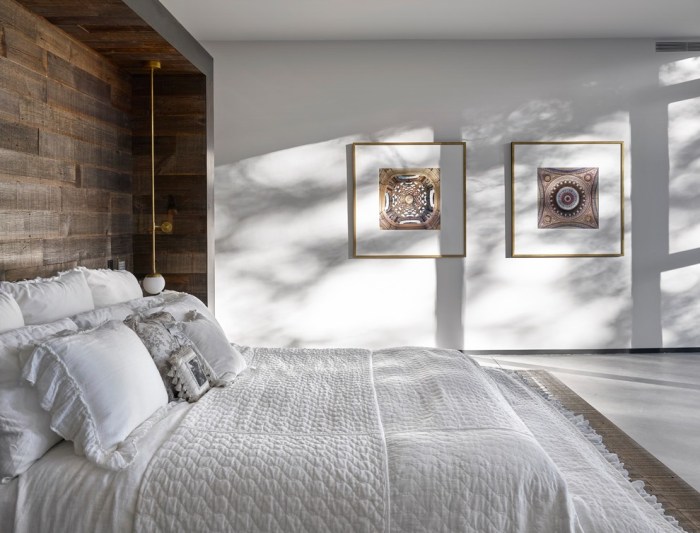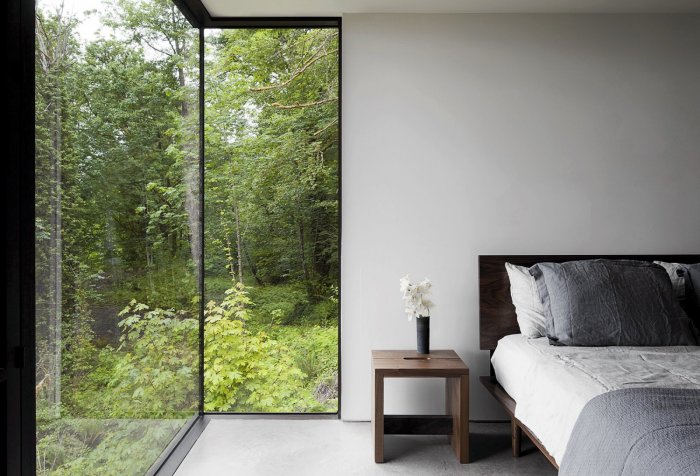Embrace the allure of nature and create a bedroom sanctuary with floor-to-ceiling windows. These expansive glass panels not only flood your space with natural light but also offer breathtaking views that seamlessly connect your indoor haven with the outdoors. In this comprehensive guide, we will explore the principles of bedroom design with floor-to-ceiling windows, from maximizing natural light to creating a sense of privacy, ensuring optimal furniture placement, and incorporating decorative elements that enhance the overall ambiance.
Let us embark on a journey to transform your bedroom into an oasis of tranquility and inspiration.
Whether you prefer the sleek lines of modern design, the timeless elegance of traditional style, or the simplicity of minimalism, floor-to-ceiling windows can elevate any bedroom aesthetic. Their versatility allows you to create a space that reflects your personality and lifestyle, making your bedroom a true sanctuary where you can unwind, recharge, and connect with the beauty of nature.
Design Principles
Floor-to-ceiling windows offer unparalleled benefits for bedroom design. They flood the space with natural light, creating a bright and airy atmosphere. The expansive views they provide can bring the outdoors in, creating a sense of connection to nature and expanding the perceived size of the room.To
incorporate natural light and views into the bedroom layout, consider the placement of the bed. Positioning it perpendicular to the windows allows for maximum exposure to light and views. Incorporate sheer curtains or blinds to filter sunlight while maintaining privacy.
Privacy Considerations
To create a sense of privacy while maximizing natural light, consider strategic window treatments. Sheer curtains provide a delicate balance between light filtration and privacy. Blinds or shutters can be adjusted to control the amount of light and visibility. Alternatively, consider frosted or tinted glass for windows facing public areas, allowing natural light to enter while obscuring views from outside.
Window Treatments
Floor-to-ceiling windows offer an expansive view and ample natural light, but they also require careful consideration for privacy and light control. Here are various window treatment options to enhance the aesthetics and functionality of your bedroom:
Curtains
Curtains are a classic and versatile option for floor-to-ceiling windows. They provide privacy, light control, and can add a touch of elegance to the bedroom. Consider sheer curtains for a soft, airy look, or heavier fabrics like velvet or linen for more privacy and insulation.
Blinds
Blinds offer a sleek and modern look. They are available in a variety of materials, including wood, faux wood, aluminum, and fabric. Horizontal blinds provide precise light control, while vertical blinds are ideal for wide windows and sliding doors.
Shutters
Shutters are a durable and energy-efficient option. They provide excellent privacy and light control, and can also enhance the architectural interest of the room. Consider wooden shutters for a classic look, or vinyl shutters for a more affordable and low-maintenance option.
Creative Ideas
In addition to their practical functions, window treatments can also be used to enhance the aesthetic appeal of the bedroom:
- Layer different fabrics: Combine sheer curtains with heavier drapes for a luxurious and dramatic effect.
- Add valances or cornices: Valances or cornices can add a touch of sophistication and conceal window hardware.
- Use patterned or textured fabrics: Patterns and textures can add visual interest and depth to the bedroom.
Furniture Placement
Optimizing furniture placement is crucial to fully leverage floor-to-ceiling windows. The strategic arrangement of furnishings allows you to create a seamless flow between indoor and outdoor spaces while maximizing natural light and enhancing the overall ambiance of the room.
When positioning furniture, consider the following principles:
- Focal Points: Identify the main focal point of the room, such as a stunning view or a piece of artwork. Arrange furniture to draw attention to these elements and create a visually pleasing arrangement.
- Natural Light: Position furniture to maximize the flow of natural light into the room. Avoid blocking windows with large pieces of furniture or placing furniture too far from them.
- Space Utilization: Utilize the available space efficiently by choosing furniture that is appropriately sized for the room. Consider using multi-functional pieces that serve multiple purposes, such as ottomans with built-in storage.
Balancing natural light with artificial lighting is also essential. During the day, rely primarily on natural light and use artificial lighting sparingly to supplement it. In the evening, dim the natural light and use artificial lighting to create a cozy and inviting atmosphere.
Decorative Elements
Incorporating decorative elements is crucial to complement floor-to-ceiling windows and enhance the bedroom’s ambiance. Artwork, plants, and accessories can create a cohesive and stylish design scheme.
Artwork
Choose artwork that reflects your personal style and complements the color palette of the bedroom. Large-scale paintings or photographs can draw attention to the windows and create a focal point. Consider hanging artwork at eye level or slightly above to create a sense of balance.
Plants
Plants add life and freshness to the bedroom. Choose plants that thrive in low-light conditions, such as snake plants, ZZ plants, or peace lilies. Place plants near the windows to take advantage of natural light, or use artificial light to supplement.
Accessories
Accessories can add personality and style to the bedroom. Consider using throws, pillows, and rugs to add texture and color. Choose fabrics that complement the artwork and plants, and don’t be afraid to mix and match patterns and colors to create a unique look.
Specific Design Styles
Floor-to-ceiling windows are an architectural marvel that can transform any bedroom into a sanctuary of light and openness. They offer breathtaking views, create an illusion of space, and invite the outdoors in. However, incorporating these expansive windows into bedroom design requires careful consideration of different design styles.Each
design style has unique characteristics that influence the way floor-to-ceiling windows are integrated into the space. Let’s delve into the specific design considerations for modern, traditional, and minimalist styles.
Modern Style
Modern bedrooms with floor-to-ceiling windows exude an aura of sophistication and sleekness. The emphasis is on clean lines, geometric shapes, and a neutral color palette. The windows become a focal point, framing the cityscape or natural surroundings.
- Sheer curtains or blinds allow light to filter in while maintaining privacy.
- Furniture is often low-profile and upholstered in neutral fabrics.
- Artwork and décor are kept to a minimum, allowing the windows to take center stage.
Traditional Style
Traditional bedrooms with floor-to-ceiling windows combine elegance with a touch of grandeur. Rich fabrics, ornate details, and warm colors create a cozy and inviting atmosphere. The windows are often dressed with heavy drapes or valances that add a touch of drama.
- Furniture is typically upholstered in luxurious fabrics such as velvet or silk.
- Ornate headboards and footboards add a touch of sophistication.
- Accessories such as chandeliers and mirrors reflect the light and add a touch of opulence.
Minimalist Style
Minimalist bedrooms with floor-to-ceiling windows embrace the concept of “less is more.” The focus is on creating a serene and uncluttered space. The windows provide ample natural light, eliminating the need for excessive artificial lighting.
- Curtains or blinds are often omitted, allowing the windows to blend seamlessly with the walls.
- Furniture is sparse and functional, with clean lines and simple shapes.
- Natural materials such as wood, stone, and leather create a warm and inviting atmosphere.
| Design Style | Furniture | Fabrics | Décor |
|---|---|---|---|
| Modern | Low-profile, neutral upholstery | Sheer curtains or blinds | Minimalist, geometric shapes |
| Traditional | Luxurious upholstery, ornate details | Heavy drapes or valances | Chandeliers, mirrors, antique furniture |
| Minimalist | Sparse, functional, clean lines | Curtains or blinds omitted | Natural materials, simple shapes |
Sustainability and Energy Efficiency
Floor-to-ceiling windows in bedrooms offer significant energy efficiency benefits, making them an environmentally friendly choice. These windows maximize natural light, reducing the need for artificial lighting during the day. Additionally, they allow for better air circulation, minimizing the use of air conditioning and heating systems.
Energy-Efficient Glazing and Insulation Techniques
Energy-efficient glazing, such as double or triple-pane windows, helps insulate the room by trapping air between the panes. This reduces heat loss during winter and heat gain during summer, resulting in lower energy consumption. Additionally, insulated frames and weatherstripping around windows prevent drafts and air leaks, further enhancing energy efficiency.
Maximizing Natural Ventilation and Reducing Energy Consumption
Floor-to-ceiling windows provide ample opportunity for natural ventilation. By opening windows on opposite sides of the room, cross-ventilation can be achieved, allowing fresh air to circulate and reduce the need for air conditioning. Additionally, installing ceiling fans can help distribute air evenly, further reducing energy consumption.
Final Conclusion
Designing a bedroom with floor-to-ceiling windows is an art form that combines aesthetics and functionality. By understanding the principles Artikeld in this guide, you can create a space that is both visually stunning and deeply inviting. Remember to embrace the natural light, maximize the views, and incorporate elements that reflect your personal style.
As you step into your newly transformed bedroom, let the warmth of the sun, the gentle breeze, and the ever-changing tapestry of nature inspire you to create unforgettable moments and memories.



